Oxford University Press's Blog, page 63
November 18, 2022
Big, wonderful, difficult questions (and answers) about life in Proust [interactive]
![Questions and answers in Proust [interactive]](https://i.gr-assets.com/images/S/compressed.photo.goodreads.com/hostedimages/1668848797i/33631376.jpg)
Marcel Proust—perhaps France’s most famous literary writer—died 100 years ago. The politics of his time—the criminalization of homosexuality, the Dreyfus Affair, the lead up to World War I—shaped his life and his work. So, it’s reasonable to ask, what does Proust have to say about our lives in 2022? Proust’s 3,000-page magnum opus In Search of Lost Time continues to speak through time, largely not for the answers it provides but for the questions it asks. Proust’s novel is in part about memory, love, virtue, vice, prejudice, and folly—but the core of the book is a set of big, wonderful, difficult questions about life.
Thinking about these questions today won’t help us stop climate change or rising authoritarianism—but it will help us lead a richer inner life while we do so. And the experience of reading this amazing novel—the months or years we put into reading 3,000 pages, as difficult as delightful—does important things for us too. It shows us one shape a story of a life can take. It helps us understand ourselves, nudging us to ask ourselves questions we’d never even thought about before.
Begin that journey today with this exploration of the philosophical questions Proust asks us.
Featured image: photo by Adam Bartoszewicz on Unsplash, public domain
November 17, 2022
The return of Humpty Dumpty: who is the ultimate arbiter of meaning?

“When I use a word, it means just what I choose it to mean — neither more nor less.” These are the famous words of Humpty Dumpty, a character in Lewis Carroll’s Through the Looking Glass (1871). His conversation partner, Alice, is rather sceptical:
“When I use a word,” Humpty Dumpty said, in rather a scornful tone, “it means just what I choose it to mean – neither more nor less.”
“The question is,” said Alice, “whether you can make words mean so many different things.”
“The question is,” said Humpty Dumpty, “which is to be master——that’s all.”
In philosophy of language, as well as in many court opinions (e.g., Liversidge v. Anderson, 1942), Humpty Dumpty is held up as an example of how not to think about meaning. Contrary to his claim that the meaning of his words is determined solely by his intentions, there is broad agreement that what words mean is not solely up to us—we can change their meanings over time, but that requires a group effort, and something like consensus. A speaker cannot do it alone.
150 years have passed since Carroll published Through the Looking Glass, and Humpty Dumpty still cuts a ridiculous figure. Yet in light of contemporary linguistic manoeuvrings, his idiosyncrasies appear rather benign. He may be running roughshod over linguistic conventions, but at least he is upfront about doing so. Nowadays, we must arguably contend with a more malicious, more deceitful, form of Humpty-Dumptyism.
In recent years “gaslighting” has become a buzzword in popular culture. It is defined by philosopher Kate Abramson as “a form of emotional manipulation in which the gaslighter tries (consciously or not) to induce in someone the sense that her reactions, perceptions, memories and/or beliefs are not just mistaken, but utterly without grounds” (2014). For example, women who report sexual harassment are often gaslighted by being made to believe that they are over-reacting or falsely perceiving events. Repeated gaslighting can make a person lose all trust in their abilities to interpret the world around them.
One form of gaslighting that has so far received relatively little attention is gaslighting about meaning. We can do this by encouraging our hearers to doubt their interpretations of what we said, even when those interpretations were perfectly correct. This is a kind of bad faith Humpty Dumptyism. Consider Donald Trump’s speech to his supporters in Washington, D.C. on January 6th, 2021. Trump had just lost the United States presidential election but refused to accept the result. He told his supporters, “If you don’t fight like hell you’re not going to have a country anymore,” and that, once they had walked down to the Capitol, “You have to show strength, and you have to be strong.” Two thousand people then stormed the Capitol building. When pressed on his role in this riot, Trump and his legal team claimed that he had not intended to cause a riot, and that his words could not have foreseeably resulted in one. In fact, they claimed, his speech had called for peaceful protest.
Trump and his team are gaslighting us about the meaning of his words. To a reasonable hearer, who has a good grasp on the conventional meaning of words, his speech was an incitement to violence. Yet Trump is calling this very reasonableness into question. He is denying that his words had this meaning and implying that anyone who thinks otherwise has lost their grip on reality. This is Humpty Dumptyism with an insidious twist; Trump is acting like Humpty Dumpty but refusing to admit it. Instead, he is claiming that it is his hearers who are twisting meanings. He is Alice, the voice of reason, and we are the ovate linguistic buffoon.
Trump’s behaviour may seem merely irritating, even laughable. Yet repeated gaslighting of this kind over time, especially by those in positions of power, might erode our ability to communicate. A linguistic convention comes into being when we all start using a word in the same way, with the belief that others are acting similarly. Gaslighting about meaning undermines this belief, and may ultimately cause our conventions to fall apart, leaving public discourse rife with distrust and disorientation. And just like Humpty Dumpty in his namesake rhyme, we may not be able to put them together again.
November 16, 2022
In the footsteps of our greatest favorite: vampire
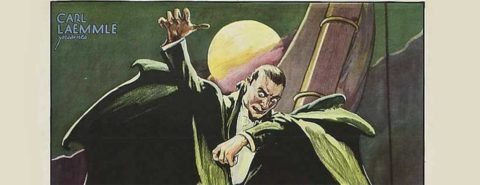
We love books and movies about vampires, don’t we? Everybody knows who Dracula was, and many people believe that we owe the entire myth to him. This, however, is not true. Below, I won’t deal with the origin of the belief but only with the history of the word vampire. My blog post is based almost entirely on the paper by Katharina M. Wilson in Journal of the History of Ideas, 46, 1985, 577-83. I will largely pass by the problems of etymology, because the word vampire and its kin inevitably take us to the lands of the Slavs and elsewhere, away from the English-speaking world. Some of the most important works on the word are in Polish and Russian. Specialists know about them, and anyone can find a few references in my book A Bibliography of English Etymology. Here, I’ll only mention the important fact that the word vampire is not Hungarian. A relatively early (and wrong) Hungarian etymology of vampire was offered by Richard Stephen Charnock, a prolific student of word origins, in Notes and Queries 4/V, 1870, p. 378.
The history of the word vampireIn France, the word vampire emerged in 1737, but some cases of vampirism were discussed at Sorbonne as early as 1693. The tale of the vampire owes its late popularity to the story by John William Polidori (1795-1821; he died at the age of 25!). Its title is The Vampyre. This 72 page-long tale, which has a most interesting history, was a tremendous success in and outside England. Its full text can now be found online. However, long before Polidori, Robert Southey brought out his poem Thalaba the Destroyer (1801; the vampire is the man’s deceased wife), and in 1813, Byron’s The Giaour appeared. Southey is almost forgotten, but Byron still languishes in some of our graduate courses. Predictably, it was not the theme of vampirism but a full-length tale by Polidori, with the word vampyre in the title, that gained popularity all over Europe.
In England, the term vampire turned up in the seventeenth century. Katharina Wilson notes that Charles Forman, in his brochure Some Queries and Observations Upon the Revolution in 1688, written in the same year but published only in 1741, used the term metaphorically (“…the Vampires of the Publick, and Riflers of the Kingdom”), without explaining the word. Rifler means “robber.” I may add that Wilson pointed to an important fact in historical lexicography. Quite often, we have no way of knowing when a certain word appeared or became marginal in English (or in any language, for that matter), and the writer’s comment or “gloss” provides a clue to the word’s age: if such a word is italicized or explained, we conclude that it is recent, obsolete, or at least rare in the language. Since Forman used vampire in a matter-of-fact way, apparently, no one had trouble understanding it, even when the bloodsucker was not a real vampire.
 Vlad the Impaler, the prototype of Bran Stoker’s novel about Dracula. That cruel ruler was NOT a vampire!
Vlad the Impaler, the prototype of Bran Stoker’s novel about Dracula. That cruel ruler was NOT a vampire!(Via Wikimedia Commons, public domain)
As far as I can judge, vampire has not yet been edited in the OED online, and Wilson provides an antedating. Here I may again go off on a tangent and add a digression. The OED was published between 1884 and 1928. One of the most prominent features of each entry was the fact the public now received reliable information about the date of the first occurrence of every word included (naturally, according to the data at the editors’ disposal). No sooner had the first fascicle appeared than the game of antedating began. For a century and a half, people have been providing the staff at Oxford with earlier citations than those found in the printed texts. Quite a few letters by James A. H. Murray, the first OED’s editor, deal with this problem. The remarkable thing is not that we now know many earlier or more precise dates than those which came to the attention of Murray’s team but how often that team did find the earliest citations still available. Be that as it may, we now deal with a more precise date of the appearance of vampire in English. It is therefore nice to know that the subjects of Charles II would have understood and appreciated The Silence of the Lambs and not only the obscene comedies of their Restoration Literature and Shakespeare’s plays.
In the 1745 book, the one to which the OED refers, we find the following passage:
These Vampyres are supposed to be the Bodies of deceased Persons, animated by evil Spirits, which come out of the Graves, in the Night-time, suck the Blood of many of the Living, and thereby destroy them.
The description is long and detailed. In Italy, vampirism was discussed in some detail in the middle of the eighteenth century. Pope Benedict objected to the cruel maltreatment and mutilation of corpses believed to be vampires. (According to a widespread belief, in order to get rid of a vampire, it was necessary to open his grave and impale, that is, pierce the corpse with a stake. A somewhat similar superstition is known from Icelandic sagas: the so-called undead, or revenants, roamed their neighborhoods and did all kinds of terrible things, even though they were not bloodsuckers; after killing them again, a special ceremony was needed to get rid of the monster.)
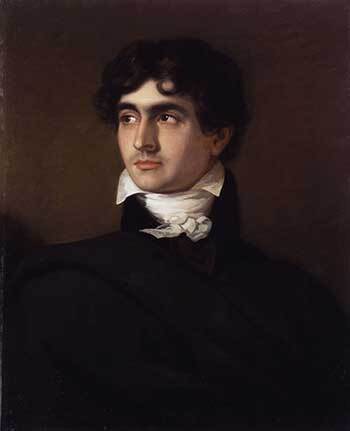 William Polidori.
William Polidori.(Via Wikimedia Commons, public domain)
Since the Pope’s work treating this subject was, naturally, written in Latin, the word that interests us also appeared in Latin, with y after p. (Polidori, as we have seen, made use of the same spelling.) Italian vampiro goes back to 1789. Especially important is Wilson’s statement that “in Hungary and Transylvania, the supposed homeland of vampires, the term ‘vampire’ exists only as a neologism and was never as popular as in the West.”
I have already noted that the Slavic etymology of vampire will not be discussed here. However, those interested in this subject should be informed that the proposed Avestan, Tartar, and Modern Greek sources of the word, should be, most probably, dismissed. The proto-Slavic form existed, but its exact shape remains a matter of debate and is of no consequence in the present context.
Two additions to last week’s gleaningsFirst. Yes, of course, the idiom is many a mickle makes a muckle. I simply paraphrased the saying. Second, Scots hallenshaker. I have already apologized for my blunder. I divided the word into three segments, namely, hall-en-shaker, because I had not consulted dictionaries and did not know the word hallen, but it seems that my guess was not entirely wrong. The OED says that the origin of hallen is unknown (and the same is said in the recent Scots dictionaries), but that it must be connected in some way with hall. This is the most obvious etymology (which of course does not mean that it is correct). Not improbably, hallen, which, curiously, looks like the definite form of the Scandinavian noun hall “vestibule, etc.,” is indeed an extended form of hall, even though the process of derivation remains unclear. See the post, “Do you blather when you skate?”.
Featured image: “Dracula (1931 film poster)”, via Picryl, public domain
November 15, 2022
What is “life-writing” and why does it matter?

Oxford University Press has recently launched its new seven-volume Oxford History of Life-Writing in English. Three of the volumes are already in print, with the latest being my own, which covers the period from 1945 to the present day. This is the first time a history of life-writing on anything like this scale has been published, which begs the question—what is life-writing, and why does it matter?
Over the last few decades “life-writing” started to be used as an umbrella term for an increasingly eclectic range of literary forms and invested with a new level of cultural importance. Partly this was thanks to the various post-war social movements which have tried to recover the voices of marginalised people and repressed experiences. Historian E.P. Thompson spoke for many when he announced the ambition of rescuing subaltern forms of self-expression “from the enormous condescension of posterity.” And of course this effort of recovery involved looking well beyond the lives recounted in biographies and autobiographies, and even diaries; it opened up a vast literary netherworld of court reports, legers, household accounts, marginalia, and graffiti.
In a parallel shift, literary texts started to be read with more attention to the kinds of experience they disclose, or which they cannot help but repress. The formalistic training offered by university English courses seemed to the feminist poet Adrienne Rich far too limited: she emphasised the need to “find out what in fact had been the lives of our artists, what in fact had been the lives of our thinkers.” Literary writing also started to change, and demand new kinds of response. Poets such as Robert Lowell and indeed Rich herself disturbed the borderlines between high art and personal disclosure; critics started coining new terms like “autofiction,” “biofiction,” and the “non-fiction novel” to describe the range of inventive new forms which keep enlarging our idea of how a life can be written.
“Life-writing [is] … an umbrella term for an increasingly eclectic range of literary forms.”
But it would be wrong to picture life-writing just as a respectable intellectual phenomenon. Its rise to prominence was also driven by a changing publishing industry, where bigger marketing budgets and a need for bestsellers generated the “memoir boom,” as it became known. With its origins in the social tumult of 1960s America, the boom really took off in the 1980s and 1990s with an enormous expansion of life-stories by hitherto unknown people, ranging from the coming out memoir to narratives about illness and disability, and (especially in Britain, it would seem) the so-called “misery memoir”. While these stories were often moving and insightful in their own terms, they also served the infotainment industry’s growing need for author-celebrities—for writers comfortable being interviewed about their lives on popular formats like the Oprah Winfrey Show, or Richard and Judy.
The most recent boom in life-writing, which further expanded the meaning of this term, came in the early years of the new millennium together with a new phase of consumer capitalism. Social media platforms brought a rapid growth in channels for written self-expression, from tweets and text messages to blogs and Facebook posts. The writing of one’s life became no longer something done mainly by important individuals who wrote an autobiography, or by sensitive souls who kept a diary, or even by people with interesting problems or adventures to share. Life-writing is now a truly ubiquitous phenomenon, part and parcel of the everyday formation of identity.
While there is certainly much to celebrate in these developments, the rise of life-writing in the post-war years is clearly bound up with changes in modern identity and in our wider commercial environment that are in many ways also quite troubling. In writing my volume of the Oxford History, I formed the view is that this remarkable phenomenon needs to be appreciated through a wide-angle lens that can take in a properly ambivalent response to its achievements.
“Life-writing of [the post-war] period … played an essential part in expanding and enriching what it means to pursue self-fulfilment.”
On the one hand, life-writing of this period can be credited with having played an essential part in expanding and enriching what it means to pursue self-fulfilment. With the easing of censorship, including self-censorship, and the increasing frankness of public disclosure that resulted, it contributed greatly to the broad social process which sociologist Anthony Giddens named “the transformation of intimacy.” Texts as diverse as confessional memoirs, lyric poems, and therapy manuals have brought what goes on inside human relationships to an unprecedented level of public scrutiny, helping to challenge and revise some of the more egregious imbalances of power. The popular dissemination of life-writing has been central to the reimagining of gender roles and the rethinking of sexuality; it has played a part in the claiming and redefining of ethnic or racial identities, and in revising our understanding of what it means to have a disability or an illness. Testimony narratives became important within various processes of historical redress, raising consciousness and generating empathic connections with the victimised and the oppressed. And many people have come to understand life-writing as having a significant therapeutic potential: learning to identify yourself with a narrative that explains what kind of person you are, and what kind of journey you are on, became essential to the ethos of empowerment which modern ways of thinking about selfhood have tended to enshrine.
“But the same processes that have transformed intimacy … also possess a considerable power to reify human experience into packaged identities.”
But the same processes that have transformed intimacy, redefined possibilities for self-expression, and started to manage our lives in various therapeutically improving ways, also possess a considerable power to reify human experience into packaged identities and unilluminating moral categories. As the language of therapy seeped ever further into the everyday, its process of self-scrutiny brought with it a rationalisation of the inner life with every bit as much ability to banalise as empower. As our intimacies become more visible and better-analysed they could also become colder, and a slick over-commodified quality started to inhabit certain kinds of modern subjectivity—both in writing and in life. While the memoir boom helped to democratise who gets to have their life-story told, it also encouraged identification and emotionalism as a way of learning about the historical past and thinking about social problems. It helped create a sentimentalised public discourse which distracts and trivialises at least as much as it informs. Glossy and ephemeral forms of life-writing started to circulate on an enormous scale, and literary culture became increasingly saturated by the celebrity industry: serious authors are now obliged to find ever more inventive ways of fending off its power to domesticate and neutralise their writing. And with the rise of the new social media platforms, such as Facebook and Twitter, there emerged an equally new potential for human personality itself to be commodified, for people to be constituted as marketing objects by our “likes” and “dislikes”.
So, while life-writing has become ever more culturally significant over the last few decades, it is likely that self-knowledge remains every bit as rare, as compromised, and as difficult of achievement as ever before.
Feature image by Julia Joppien on Unsplash, public domain
November 14, 2022
Everyday Narnia: the language of another world

The release in 2021 of Norman Stone’s biopic movie, The Most Reluctant Convert: The Untold Story of C.S. Lewis, demonstrates how the interest in Lewis and his creation of Narnia shows no sign of abating. In the movie’s publicity, it depicts how “An elder C.S. Lewis looks back on his remarkable journey from hard-boiled atheist to the most renowned Christian writer of the past century. . . . Beautifully filmed in and around Oxford, this engaging biopic follows the creator of The Chronicles of Narnia from the tragic death of his mother when he was just nine years old, through his strained relationship with his father, to the nightmare of the trenches of World War I to Oxford University, where friends like J.R.R. Tolkien challenge his unbelief.” The film is actually narrated direct to camera by the actor playing Lewis while the events of his life are played out behind him.
Lewis’ creation of Narnia is also currently enjoying a new lease of life as a London West End stage musical of The Lion, the Witch and the Wardrobe, the latest of several stage adaptations. The production’s publicity invites audiences to “Step through the wardrobe into the magical kingdom of Narnia” for the staging of a book that has been “Voted the nation’s favourite novel.” London underground advertisements for the stage production carry the tag line “All aboard for a bewitching return to Narnia,” and the theatre too invites audiences to “Step Through The Wardrobe – At Gillian Lynne Theatre.’
There is little doubt that “Narnia” has effectively entered the English language and that references to a “wardrobe” or “wardrobe door” have been given additional meanings by C. S. Lewis: any reference to it requires no explanation simply because everyone knows. “Narnia” is an accepted word in Microsoft’s spellcheck, and when finalising my book on 11 February 2021, the BBC Radio news, in referring to unusual temperatures as low as minus 23 degrees Celsius in the Scottish Highlands, described the snow in Braemar as “Narnian.” Even in the realm of current affairs, references to “Narnia” frequently occur: for example at the time of going to press in November 2021, the journalist Paul Goodman referred to “the resumption of normal politics, as Covid’s Narnian winter thaws” on the assumption that most will understand the reference.[1] Recently, when watching one of those house makeover/renovation programmes on television with my son and daughter-in-law (who were themselves at the time renovating a property), the presenter came to a door in the wall and announced “Da-daa: a Narnia moment!” and opened the door into …. a home office. On collecting some printing from a converted stables at a stately home in Selkirk recently, the printer told us to cross the courtyard and open that door “into Narnia,” which we duly did: into the manicured grand landscape of the grounds of the stately home.
Sculptures of Aslan, the White Witch and Mr Tumnus have replaced medieval sculptures at a twelfth-century church in Yorkshire and the characters are commemorated in the Story Museum in Oxford where the visitor is invited to enter “The Portal” to explore the museum. The novelist Francis Spufford has written a new Narnia book entitled The Stone Table that is set before The Lion, the Witch and the Wardrobe (although publication is not allowed for copyright reasons) and another novelist, Piers Torday, has written a novel entitled The Lost Magician loosely based on The Lion, The Witch And The Wardrobe where four children at the end of the Second World War enter an enchanted world through a mysterious magic door; the book is openly described as “an ode to the world of Narnia.” Lewis himself is commemorated by a life-sized bronze statue (of a poor likeness of himself opening a wardrobe door) and a city square named after him in Belfast, as well as by a stage play of his relationship with Joy Gresham which was made into a movie, Shadowlands.
The first three books of the Chronicles of Narnia have famously been made into films by Disney, released between 2005 and 2010; a fourth was planned but never materialised. In 2018 Netflix acquired the rights to the entire series, planning new films and/or television series of all seven books of C. S. Lewis world. Narnia, as Lewis himself rightly predicted as far back as 1956 in the final novel, just keeps going “farther up and farther in.”
Featured image by PxHere, public domain
November 12, 2022
From orchestra to cello solo: the gentle art of arranging music
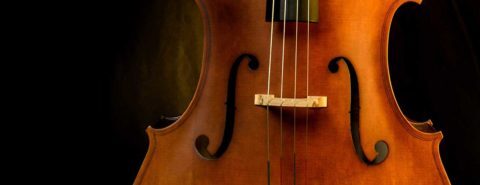
Art has always been transformed from one form to another: books to films, plays to operas, even music to novels—Beethoven’s Eroica and Anthony Burgess’s Napoleon Symphony, for example. A particularly rich example is Shakespeare’s Romeo and Juliet: based on an English narrative poem, in turn based on a French translation of an Italian tale, it’s been turned into countless films, an opera by Gounod, a ballet by Prokofiev, a Broadway show, a rock musical, and even an animation comedy about garden gnomes.
Within music, composers have been equally ready to adapt and modify. A love song of 1600 became a Baroque sacred chorale for Passiontide (Bach’s Passion Chorale), while a Bach Siciliano for flute has been reimagined as a jazz waltz by Bill Evans. In both cases the reinterpretations can be transformative, revealing striking new aspects of the original. But many arrangements are concerned more with keeping the essence of the score, while presenting it with different instrumentation, or transposed, or shorter. The rise of the piano as a domestic instrument in the nineteenth century, coupled with the paucity of readily available live concerts, created a drive to arrange classical symphonies and other works for piano duet. These generally present the content of the original in a way suitable for four hands at one keyboard—e.g., omitting some of the octave doublings—and in a manner suited to the piano—replacing a drum roll with an octave tremolo and making use of the sustaining pedal. It may not be an exact rendition of the original, but it preserves its integrity.
For musical arrangements with an educational purpose there are other considerations. Principal among these is to ensure that the arrangement suits the technical (and musical) level of the student, so that, while it may present some challenges, these are not insurmountable and are fitting for the student. The technical requirements of music exam boards present a detailed structure to guide these considerations, but even without these it is obvious that string players will only be confident exploring higher positions and more extreme flat keys after a certain amount of study, and that fast left-hand octaves and wide melodic leaps will perplex beginner pianists. To be successful, it’s important to select repertoire to arrange that is appropriate both to the instrument and to the level of the player.
“Arranging for the cello is something of a joy since it is at home in so many types of repertoire.”
Arranging for the cello is something of a joy since it is at home in so many types of repertoire and is expressive across such a wide range. Maybe its natural habitat is amongst soulful pieces with wistful or poignant melodies. Pieces such as Mascagni’s well-known “Intermezzo” from Cavalleria rusticana or Schumann’s lyrical song “Die Lotosblume”, dedicated to his wife Clara, suit the instrument perfectly. Because the cello “sings” so readily, especially on the top two strings, even melodies originally written at soprano pitch, such as Vivaldi’s “Nulla in mundo pax sincera” or the “In paradisum” that closes Fauré’s Requiem, can be transposed down an octave and still work well. At the same time, strong melodies written in a baritone range, such as Handel’s energetic aria “O Ruddier than the Cherry” from Acis and Galatea, are particularly effective. Then it is a matter of fashioning a stylish and idiomatic piano part from the original to provide an accompaniment.
Sometimes more intervention in an arrangement is needed. The original of de Falla’s song “Jota”, from Siete canciones populares espanolas, has a lively strummed guitar-like piano accompaniment, while the singer is restricted to a recurring soulful melody. The cello can do both, switching between pizzicato chords that readily imitate the guitar and the heartfelt melody. Bach, an inveterate borrower of his own and others’ music, provides another example. An aria with a significant obbligato for “violoncello piccolo” crops up in both his Hunt Cantata, BWV 208, and a later sacred cantata, BWV 68, which also introduces a joyful folk-like melody. An arrangement adding this onto the form of 208 makes a satisfying duo for cello and piano, with both parts delighting in Bach’s themes and counterpoint.
Arrangements serve a purpose of bringing fine repertoire to a new audience. With care and imagination they can be satisfying in their own right whilst also leading the curious player back to the original.
Featured image by Dominik Scythe on Unsplash, public domain
November 10, 2022
A new OUP journal connecting health and infrastructure

This week sees the launch of our new journal, Infrastructure and Health: Big Connections for Wellbeing, or OOIH for short.
Humanity strives to and achieves progress through infrastructure. Infrastructure provides the hardware, tools, and services for a connected and functioning planet. Those connections are not just for humans but whole ecosystems. But the world faces challenges that require infrastructure to be bold in scope and ambition, dynamic and adaptive, and full of vision and aspiration. Ecological devastation, climate justice, health inequity, compounded by popular distrust in politics and institutions, has cemented the need for infrastructure that covers all dynamics, human and environmental, between the planetary and nano-particle. Above all, the new era of the Anthropocene requires infrastructure that emphasises big connections for wellbeing.
OOIH provides a new unique scholarly and policy platform and outlet that has never been more urgent. Connections between big boundary spanning ideas like the Sustainable Development Goals are foundational. Links across sectors and disciplines is the journal’s necessary function. And above all, our aim for OOIH is to challenge the status quo to be bolder, better, innovative, adaptive and accountable.
“The world faces challenges that require infrastructure to be bold in scope and ambition, dynamic and adaptive, and full of vision and aspiration.”
Supporting the launch are three foundational articles. An introduction to the journal by us as Editors in Chief, a response to our introduction by editorial board member Prof Phil McManus, and reflections on the political nature of infrastructure from editorial board member, Toks Omishakin (the Secretary of the California State Transport Agency).
Read the OOIH articles:“Infrastructure and Health: laying down the big connections for wellbeing” by Dr Patrick Harris and Prof Evelyne De Leeuw“Infrastructure, health and urban planning: Rethinking the past and exploring future possibilities as a response to Harris and De Leeuw” by Prof Phil McManus“The Built Environment, People at Its Axis” by Toks OmishakinThe journal is accepting submissions year-round. We expect to have four editions per year made up of a mix of article types. As per instructions to authors, original research, reviews, reflections and visually based “narrative” pieces are welcome. If you have a novel idea to progress the field, we are keen to hear from you before commissioning Editorials.
Featured image by Ankit Dembla on Unsplash, public domain
November 9, 2022
Post-summer gleanings
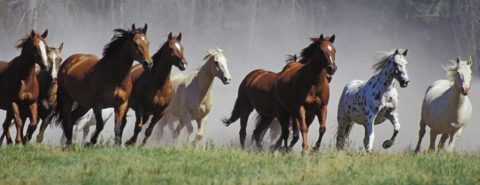
Every mickle makes a muckle. Though (alas!) I cannot say that after every post I receive dozens of letters (as happened, for example, to William Safire, who for a long time was responsible for the NYT word column), I know that the blog is read by many people and in many countries. It was launched on 1 March 2006, and this is the 867th time it offers some information on word origins to the public. My latest “gleanings” appeared in August. To quite a few letters I answered personally, but some responses will end up in this column.
The origin of the word raceSee my post for 22 April 2009: …Race, Class, and Sex…. And don’t miss the comment on Shakespeare. The question (asked long ago but never answered in my later gleanings) was about the other rejected etymologies of this word. In addition to what I mentioned in 2009, I may refer to the following improbable sources of race: Venetian narrazza (from Latin generatio) “procreation”; Latin raptio “a brood of young birds” or the corresponding verb raptiare, and Arabic ra’s “head; origin.” No one doubts that English borrowed race from French. It is therefore the French word whose origin we should explore. Incidentally, discovering a possible foreign etymon does not suffice, it is necessary to trace the route of the word from its conjectural home to another language.
A few forgotten proposals are fanciful and don’t even deserve a mention, but one is curious. Hensleigh Wedgwood, Walter W. Skeat’s main nineteenth-century predecessor in the area of English etymology, tried to derive race “competition” and “a group of humans” from the same source meaning “rapid movement.” The most complete list of references can be found in Ernst GamiIlscheg’s second edition of his etymological dictionary of French, but he offered almost no discussion. Instead, he mentioned the suggestions he did not accept and focused on his own. (He remained true to the Langobardian-Old High German origin of the Italian word described in my old post.)
I have not seen any new works on the etymology of race published since 2009, the year I wrote that post, but it does not follow that such works do not exist. Finding a publication in this area is harder than discovering a needle in the proverbial haystack. But I have consulted several recent dictionaries and with a single exception, predictably from Italy (this dictionary was also noticed by the OED’s team), did not find references to the paper that seems to have solved the problem once and for all. As explained in the 2009 post, Gianfranco Contini showed that the concept of race had originated in the business of horse breeding. His paper appeared in Studi di filologia italiana 17, 1959, 319-327; it is in Italian. Incidentally, the racist interpretation of the word race goes back to Arthur de Gobineau’s terrifyingly influential four-volume Essay on the Inequality of Human Races (1853-1855; in French but translated into many languages). It therefore need not surprise us that the concept of race originated outside the sphere most familiar to us today.
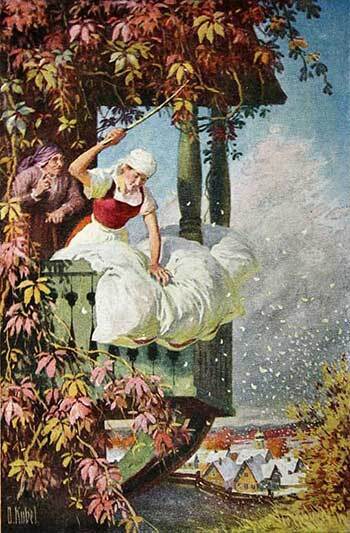 Frau Holle is good to diligent girls and punishes the lazy ones.
Frau Holle is good to diligent girls and punishes the lazy ones.(Image by Otto Kubel via Wikimedia Commons, public domain)
Even the extremely well-informed Gamillscheg paid no attention to this article. Equally well-read is Elmar Seebold, the latest editor of the main etymological dictionary of German. He refers to numerous recent publications, but Contini’s article is not mentioned. I very much doubt that he follows this blog, and anyway, the latest edition of Kluge-Seebold appeared in 2011, so that he would not have had enough time to incorporate the information going back to 2009. However, the title of Contini’s article contains the key word razza! The post-1959 English dictionaries usually say that the origin of the word is unknown. Only the online edition of the OED mentions the correct derivation (without discussing it).
The situation with race is typical. An ingenious etymologist makes a discovery, and no one notices it. Non-specialists consult the most easily available dictionaries or read “Etymoline.” There, in the entry race, they will find reference to Ernest Klein’s 1966 English etymological dictionary, an unoriginal and unreliable source. (Unrelated to race: even in serious articles, I sometimes see references to Eric Partridge’s etymological dictionary, the last work one should use, except for some superficial information.) Conclusion: the origin of race is “known”!
Variants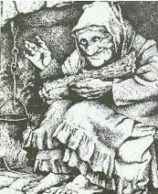 Frau Trude large as life but half as natural.
Frau Trude large as life but half as natural.(Image via Fairytale Wiki, CC BY-SA 3.0)
My most recent post was titled “In one’s stockinged feet.” The comment from a reader was to the effect that he had never heard this phrase with the form stockinged (only in one’s stocking feet). I think stockinged, the version mainly familiar to me, is British, while the form without -ed is American. The comment did not surprise me: people grow up with some grammatical form or pronunciation, may never hear competing variants, and can barely believe that those variants exist. When in doubt, “look it up in a dictionary.”
FolkloreA correspondent remembered her great-grandmother mentioning LADY HOONDERLARLY living in the attic and disliking rowdy children. Do I know anything about that creature? No. The questioner’s ancestors, as she wrote, are Irish and Scottish, but the reference made me think of Germany. In the Grimms’ tales, we find two “mothers” or “ladies”: Mutter Holle and Frau Trude. Both are imports from so-called lower mythology: they are demonic creatures punishing (or rewarding) children. Frau Trude is an especially cruel creature. It is beyond my comprehension why some people in Germany called their hotel “Frau Trude.” Hoonder sounds like German Hund “dog,” but –larly evokes no associations. It looks like a garbled version of some other word. As usual, I hope that some of our readers have similar memories and may provide more information. At first blush, an association with alairy (to which a very old post was devoted: “One, Two, Three, Alairy”) looks improbable.
 Old bones burn well.
Old bones burn well.(Photo by Mikhail Nilov, via Pexels, public domain)Bonfire
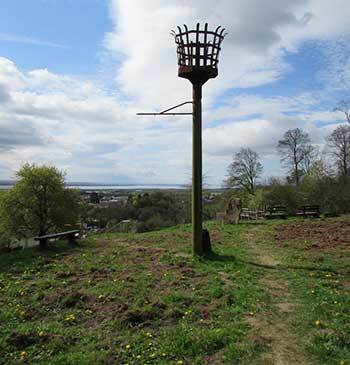 A very modern beacon in a medieval style.
A very modern beacon in a medieval style.(Photo © Jaggery (cc-by-sa/2.0)
See Osteological folklore: bonfire: 30 March 2022. I am grateful to our readers for the remarks adding interesting details to my description of bonfires and burning bones. One fact is clear: bones were indeed burned, and bonfire is a compound made up of the words for “bone” and “fire.” The word balefire hardly contains reference to bale “bundle, package,” because balefires were used mainly as beacons. Danish baun, really bavn, is related to English beacon (Old Icelandic bákn) and not to bone (Old Icelandic bein). Finally, I am grateful to Peter Gilliver for his note on Robert Griffith. Etymology is depressingly anonymous. Even specialists may not know who explained the origin of a difficult word. And I was sure that Peter would have enough information on someone so knowledgeable as Griffith. High time somebody produced a book titled “Who Is Who in Etymology.”
And finally, my usual request. If you have read an old blog post and want to add a question or comment, don’t post it there, because I have no chance to discover it. Add it after the most recent blog post.
Featured image by TNS Sofres, via Flickr (CC BY 2.0)

November 8, 2022
Defining “democracy”

One week before the 2022 US midterm elections, President Joseph Biden delivered a prime-time address at Union Station in Washington, DC. The 2 November 2022, speech came amid widely reported attempts at voter intimidation and political violence, most notably in the 28 October in-home attack on Paul Pelosi, husband of Speaker of the House Nancy Pelosi.
These were the immediate occasions for the president’s remarks, which framed our present as a “defining moment.” But Biden suggested that something more foundational, more fundamental, was at stake. He reminded listeners of the definition of democracy.
“Democracy means the rule of the people, not the rule of monarchs or the moneyed, but the rule of the people,” the president explained. “Autocracy is the opposite of democracy. It means the rule of one, one person, one interest, one ideology, one party.”
That definition seems basic—but it is far from easy or uncontroversial. Twitter lit up with assertions that the United States is a “constitutional republic,” not a “democracy.” Such fighting is perhaps one of the inevitabilities of any social media platform. Arguments over basic definitions have established themselves as a defining mark of US democracy of late.
Our current state of affairs is no doubt cause for urgent concern. If we have no shared values, or refuse to accept electoral defeat and abide by the constitutionally mandated peaceful transfer of power, we are surely in trouble. Still, US history provides myriad evidence that such conflicts over basic definitions and pathways of implementation stand as enduring dilemmas of democracy across time.
In fact, arguing over who we are—what democracy means—is part of democratic deliberation itself, a necessary component of American civic life and civic education. When the Educating for American Democracy (EAD) initiative sought to create a roadmap for excellence in history and civics, a fundamental dilemma was how to refer to the “United States”: Was it a republic or a democracy?
“Arguing over who we are—what ‘democracy‘ means—is part of democratic deliberation itself.”
The question has served as more of partisan red-herring than anything else. (Both terms were used at the founding.) But its persistence matters insofar as the language here raises concerns about basic values and tensions among them, between “populist and elitist representative form of governance,” as EAD Steering Committee Chair Louise Dubé has put it.
We tend to think of civics as the domain of history and political science. These fields—and many others—are certainly central. But as the president’s speech revealed, language is a crucial, if often neglected, component of democratic life.
As we contend in Democracies in America: Keywords for the Nineteenth Century and Today, “democracy as an ‘unsettled idea,’ full of contradictions and perhaps irresolvable dilemmas, is not a bad thing. To the contrary, that condition of unsettlement is precisely what facilitates debate and discussion, contestation and conflict, hopeful revision and powerful protest: in short, the very lifeblood of democratic philosophy and practice.” The work of defining democracy should not mean coming up with one fixed meaning about terms such equality or representation; deliberation matters. Moreover, doing this work requires a deliberate meditation on what democracy and related concepts mean and might mean.
Even as deliberation and contestation remain inherent to democratic systems, we likewise recognize, especially in our current moment, the need for shared values, the common purpose of citizens sharing the rights and responsibilities of our collective lives together.
In a recent report, composed of 31 recommendations for the reinvention of American democracy in the twenty-first century, the Commission on the Practice of Democratic Citizenship acknowledges that “citizenship can be understood broadly in two ways.” In one sense, citizenship designates “a formal status within a state that affords political participation, including the vote, and implies certain obligations of engagement or participation in state activities.” More broadly defined, “citizenship is an ethical notion,” not bound to legal status. “It centers on participation in common life, contribution to the common good, and a spirit of obligation to interests greater than one’s own.” The Commission acknowledges that this second definition is contested territory, but they are not alone in thinking that we all benefit when we find common ground with all of our neighbors as we navigate the challenges of shared living.
That common life was something that Biden was calling all of us. “For democracies are more than a form of government,” he remarked. “They’re a way of being, a way of seeing the world, a way that defines who we are, what we believe, why we do what we do.
Especially at a time when it seems like many Americans simply aren’t speaking the same language, we would do well to remember this deliberative ideal, and return to the very words that divide and, perhaps, unite us.
D. Berton Emerson and Gregory Laski are co-editors of Democracies in America: Keywords for the Nineteenth-Century and Today. The book brings together a diverse group of intellectuals to reflect on twenty-five key terms that offer us a language to deliberate about the possibilities and problems of democracy in America, past, present, and future.
Featured image: Steve Harvey on Unsplash, public domain

November 7, 2022
Delegitimising “reverse racism”

“Affirmative action? That’s just reverse racism!” We’ve all heard claims like this; the term “reverse racism” used to attack some progressive project. If you’re anything like me, something about it strikes you as fundamentally misguided. You might wonder: “Reverse racism? Is that even a thing?” You wouldn’t be alone. Some even view the concept as little more than a white-supremacist construct. People suspicious of the term often adopt one-way definitions of racism. These are thought to delegitimise the concept “reverse racism.” But do they really?
“Reverse racism” is typically used to talk about anti-white bias, but defining it properly depends on our definition of “racism.” Defining “racism” is a tricky business, with many rival views floating around in the literature. Some scholars define it in terms of irrational beliefs about race. Others, as immoral racial disrespect. Others still, as essentially synonymous with white-supremacy.
Definitions divide into one-way and two-way accounts. On one-way accounts, racism has an inherent direction, perhaps white-to-non-white or privileged-to-oppressed. Racial biases that go in the other direction don’t count as racism. We can think of one-way racism as having two sets of features: “general racism” features, e.g. irrational racial prejudice, and “directional” features, such as power dynamics. Two-way accounts have only general features, not directional ones.
One-way accounts are often thought to delegitimise “reverse racism.” If racism has directional features, anything that lacks them (including the things called “reverse racism”), can’t be proper racism. The problem with this reasoning is the assumption that, if reverse racism is not proper racism, then the concept is delegitimised. Let’s take a legitimate concept to be one that’s coherent, and refers to something worth referring to. Does a one-way account make “reverse racism” illegitimate in this sense? Quite the opposite.
On one-way accounts, proper racism has general features and directional features. Let’s assume that at least some of what makes proper racism bad comes from the former. This creates an opening in conceptual space for a term to refer to all the things that share the “general racism” features but differ in the directional features. It leaves an open door for someone to take this set of things and refer to them as “reverse racism.”
So, not only do these one-way accounts fail to delegitimise the term, they actively make it legitimate. Compare this to two-way accounts. On these, “reverse-racism” really would be an incoherent concept; there’s no inherent direction to racism that can be reversed.
Even though one-way accounts fail to delegitimise “reverse racism” as a concept, one might still think they will delegitimise the move of using it to attack things like affirmative action. At the very least, these accounts can say that something important to so called “proper racism” is lacking in reverse racism.
Of course, this doesn’t delegitimise the move so much as slightly reduce its effectiveness. People who refer to “reverse racism” may happily agree that reverse racism is less significant than proper racism. Nevertheless, they’ll point out, both are bad things! It also isn’t clear on one-way accounts just how much less significant “reverse racism” would be than proper racism of some similar variety. For example, violence motivated by racial-hatred seems pretty serious regardless of the race of the participants!
Two-way accounts, I argue, are better for delegitimising the more contentious appeals to “reverse racism.” As I’ve highlighted, they properly delegitimise the concept by making it incoherent. However, they can also delegitimise the way it’s used to attack progressive projects. First, two-way accounts are just as able as one-way accounts to say that racism absent some directional feature is less significant. Second, two-way accounts typically have other features that would prevent many progressive measures from being racist. They don’t regard just any differential racial treatment as racist. Definitions that identify racism with immoral racial prejudice can say that affirmative action (etc.) lacks the immorality required for racism. Definitions that identify racism with irrationality can deny that these progressive projects are irrational.
These kinds of restrictions are less easily undermined. One-way requirements restricted the definition of racism in a way that left a coherent and significant concept available to use and abuse. To pull a “reverse racism” with the restrictions in two-way accounts, one would have to use a concept like “non-immoral racism” or “non-irrational” racism. But notice how weak a line of attack this is. “Down with affirmative action! It’s like racism, just not immoral!” would be a difficult chant to get going at even the most determined rally.
Seeing people use “reverse racism” to attack progressive projects can be frustrating, but the way to combat this isn’t to assert that certain groups cannot be victims of racism. If delegitimising “reverse racism” is your goal, then you’re better off with two-way accounts of racism than one-way accounts.
Featured image by Markus Spiske on Unsplash, public domain

Oxford University Press's Blog
- Oxford University Press's profile
- 238 followers



